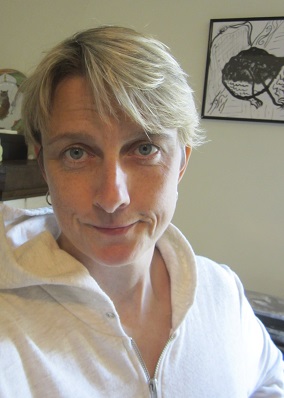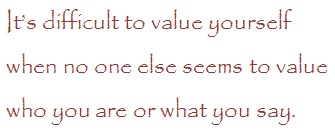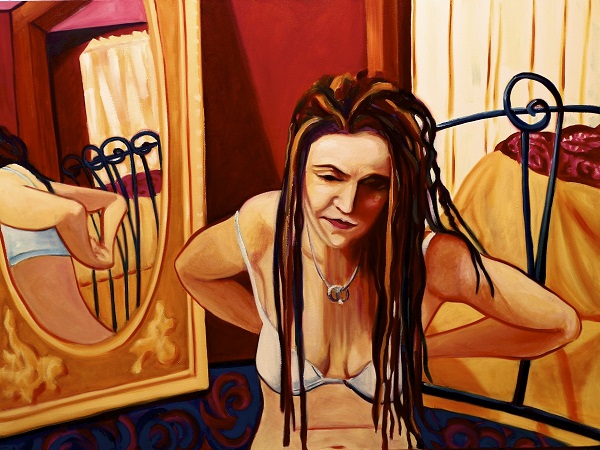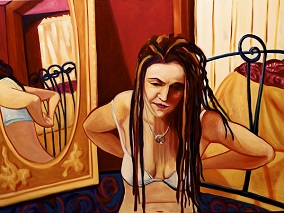 Working with a community organization in Minneapolis, artist Christi Furnas not only helps other artists with mental illnesses to improve their art-making skills, but does so in a safe space that is free of stigma. As someone who was diagnosed with schizophrenia, Furnas uses her history of mental illness in order to inform how to help others who are going through similar experiences. Here, Furnas discusses the intersection of the role art and the creation of beauty play towards a deeper level of communication.
Working with a community organization in Minneapolis, artist Christi Furnas not only helps other artists with mental illnesses to improve their art-making skills, but does so in a safe space that is free of stigma. As someone who was diagnosed with schizophrenia, Furnas uses her history of mental illness in order to inform how to help others who are going through similar experiences. Here, Furnas discusses the intersection of the role art and the creation of beauty play towards a deeper level of communication.
Chelsey Clammer: You have been a member of The Spectrum ArtWorks program for about a decade. What does the program do and how did you become involved in it?
Christi Furnas: Spectrum ArtWorks is an art program located in Minneapolis, MN that supports adult artists living with a severe and persistent mental illness. We are part of a Community Support Program called the Lighthouse which is a drop-in center for adults with a mental illness. People hang out and have a safe space; a place without violence, disrespect or stigma. The CSP also provides services such as housing assistance, health and wellness groups and a lot of fun activities.
I got involved with Spectrum ArtWorks when it was in the beginning stages. A friend told me about an art group for people with mental illness. My response was basically to roll my eyes and say no thank you. Then he mentioned free art supplies. So I checked it out. What I found was lasting friendships and an addition to my support network. I’ve been introduced to people and artwork that I would’ve never have known about.
CC: What is your role in the program as a Peer Support Specialist?
CF: In March 2011, I was hired on as staff. I support 12 people who are working to survive as professional artists. I help them apply for shows, and keep up portfolios along with other things. There is great talent in the group and I have learned a lot. Another aspect of my job is to help facilitate open studio time. This is when any member of the Lighthouse can utilize the studio and art supplies. This is not art therapy although it is an excellent time for people to be creative in a comfortable setting.
 I have a unique roll because I get to support peeps as an equal. I don’t see it happen where I work, but in a great number of situations people with mental illness are patronized or not listened to. It’s difficult to value yourself when no one else seems to value who you are or what you say. I have the opportunity through art making to connect with people. It is important to hear stories from people and be able to share experiences. The other day I compared auditory hallucination stories with an artist in the program. Then I discussed which colors to use in their painting. I feel extremely fortunate to work in the arts at a place I can be open about my illness.
I have a unique roll because I get to support peeps as an equal. I don’t see it happen where I work, but in a great number of situations people with mental illness are patronized or not listened to. It’s difficult to value yourself when no one else seems to value who you are or what you say. I have the opportunity through art making to connect with people. It is important to hear stories from people and be able to share experiences. The other day I compared auditory hallucination stories with an artist in the program. Then I discussed which colors to use in their painting. I feel extremely fortunate to work in the arts at a place I can be open about my illness.
CC: In the past twenty years (if not longer), there has been much discussion about mental illness fueling creativity. I’m thinking here about the release of Kay Redfield Jamison’s book Touched with Fire and the emergence of activist/support groups such as The Icarus Project. What is your perspective about the relationship between mental illness and creativity?
CF: I have identified as an artist since I was a child. It was with me before and throughout my illness. Art is a form of communication and a universal language. I found that at times, one of the ways to get my thoughts out was to draw. These drawings were early in my diagnosis and may be interesting to some, but I have moved beyond that point in my life. Having gone through many doctors, therapists, and medications, I now have control of my thoughts without a constant fear of suicide. The word recovery is used for where I am in my life today. That is not the same as a cure. My episodes are shorter and easier to control, but when I experience symptoms I literally hide and am barely able to speak. It is uncomfortable physically and mentally. The different forms of pain are from schizophrenia and not from stigma. I am paranoid and hear things that are terrifying. I feel things crawling on my skin. I am not thinking about my next creative project.
At the beginning of my diagnosis, I drew like I didn’t care if I lived or died. Now I paint like every day is precious. I have a commitment to each painting; I rework and revise. If someone were to say that my art has suffered due to my recovery, I would disagree. I look at some of my old stuff and cringe. I’ve been through many medication switches. I kept sketch books from different times and I can tell by looking at my drawings which meds didn’t work. The medications that I am on now help keep me alive and comfortable. I would never trade that to go back. In fact, one of the methods I used to keep myself alive was to tell myself that the next drawing/painting would be better so I couldn’t kill myself “yet.” My paintings are better. So, I was right!
My illness is part of who I am, and I put everything I have into my artwork. So it would be hard to separate the “crazy” me with the “artist” me. But as for psychosis fueling creativity, I would say that it may make for some interesting stories that I would never want to relive. But, there is so much to take from life, so many different observations and experiences, I don’t think unneeded suffering is a necessary component of creativity.
CC: Have you seen any shifts in regards to the permutations or amount of stigmatization of mental illness in our society?
 CF: Stigma is everywhere. I believe it is starting to get better slowly. On the one hand, we have bad movies and endless news reports blaming violence on the mentally ill. On the other hand, there are organizations like The National Alliance on Mental Illness (NAMI) and countless people working to advocate for us. More people seem to be speaking out about their own experiences.
CF: Stigma is everywhere. I believe it is starting to get better slowly. On the one hand, we have bad movies and endless news reports blaming violence on the mentally ill. On the other hand, there are organizations like The National Alliance on Mental Illness (NAMI) and countless people working to advocate for us. More people seem to be speaking out about their own experiences.
What I find is that people are afraid of the unknown. It seems completely logical to me that anyone would be scared if you don’t know anyone that has told you about their mental illness. I’ve seen the statistic that one in four people will experience some kind of mental illness in their lifetime. If that is true, then we all know someone that is suffering.
I have been “out” to my friends and family as having schizophrenia before I went public with it. There are a couple of reasons. First, my family is awesome and has always been supportive and loving. And second, I wanted people to know, so if I went out of my mind around them, they would have some reference and therefore be able to react in a less frightened manner.
When someone asks what I do for work, I tell them that I work in an art department in a drop-in center for adults with mental illness. The reaction I get is something to the effect of, “Wow, good for you. It takes the right kind of person,” or “Hats off to you. That must be really difficult to work with those people.” This reaction always takes me off guard and I lose the opportunity to school the person. My answer seems to be, “It’s actually a lot of fun.” So when people are even being kind, there is a lack of awareness. But on a personal level, I’ve at least seen more kindness over the last number of years.

CC: As a community organizer through the arts, what are some of the challenges you have seen organizations such as Spectrum ArtWorks face, and what actions have helped to address/challenge/eradicate them?
CF: It is a challenge for anyone to live as a professional artist. The population of people I work with can have issues with poverty, housing, chemical dependency. Some folks have had a run in with the law. When you are always in crisis, it’s hard to focus on your career. The members of Spectrum ArtWorks are dedicated but have a lot going on. Our organization tries to take a holistic approach. We support each person, the best we can, with their goals.
Another huge challenge is access to the arts. Minneapolis has an amazing arts community. I know that there are more opportunities here than in many areas. I try to tell the people that I work with that art is not a competitive sport, but we are going after the same grants, applying for the same shows, trying for the same sales with other artists and organizations. Many of the juried shows, the judges look at an artist’s education. Few of our artists have an MFA. A lot of times that means you are not even considered. It can seem like running on a wheel. Rejection is a regular occurrence for an artist. This is especially difficult for people who constantly face discrimination. Mental illness is often a judgment against a person’s character. So receiving a rejection letter is devastating. Many members would not put themselves out there if they didn’t have the support that we give. I try to keep my eye out and my ear to the ground, try to keep the challenges coming. I have occasionally taken a Wonder Woman stance and announced “Challenge!” When folks get down, I just remind them that it’s just about making art. Your job is art. Art is fun. Just have fun. If you enjoy what you do, your work will show it, and more people will eventually buy it. Then I smile.
CC: What are some changes you hope to see in regards to stigmatization of mental illness, and how do you think the arts can help to make those changes?
CF: The worst stigma I have experienced has been my own. When I was diagnosed, I didn’t know what schizophrenia was. I had to research it on dial up. That was frustrating. And terrifying. You can imagine what happened to my self-image. When you are given a life sentence with the possibility of death, it hits hard. My symptoms got worse with the news. The naming of what was going on made the illness even more life threatening. It’s like being diagnosed with cancer and given your chemo to take home, which makes you sick. Then they tell you to call if you feel like you are close to death so they can lock you up and give you more chemo.
Mental illness is an illness. It took a while for me to comprehend that. And when I did, I noticed other people in the world didn’t realize it either.
 At the place I am now, I do not deny my illness, but I do not identify myself by it either. My identity is complex and simple and nonexistent at the same time. Other Buddhists might understand what I’m trying to say. I’m not going to get into an existential conversation right now. What I am going to say is that I try to present the person that I aspire to be to people while trying to be honest about who I am to myself. At times, these two things merge. That is beauty. People recognize beauty, and it’s hard to hate and fear beauty.
At the place I am now, I do not deny my illness, but I do not identify myself by it either. My identity is complex and simple and nonexistent at the same time. Other Buddhists might understand what I’m trying to say. I’m not going to get into an existential conversation right now. What I am going to say is that I try to present the person that I aspire to be to people while trying to be honest about who I am to myself. At times, these two things merge. That is beauty. People recognize beauty, and it’s hard to hate and fear beauty.
Like I said before, art is a form of communication. It connects our thoughts and emotions with others. We see parts of ourselves in other people’s work. The beauty that is conveyed on a canvas can move through the viewer’s eyes to their soul. It has that potential. Or maybe through a good song. Or a play. Or a good book. Something connects that is beyond a casual conversation. When I connect with someone through art, they see that we are the same in some way. When people see that we are all the same in some way, that breaks down stigma.
CC: Tell me about your own artwork. With what medium do you engage and how do you approach your artistic work?
CF: I enjoy working with oil paint. The subject is usually figurative, with exaggerated lines and color, and distorted proportions and perspective. I have fun while I lay the brushstrokes on thicker and brighten everything up. Contrast comes from a mixture of pigments, as I rarely use black on my canvas.
I always seem to go back to my line drawings, as well. I work small, mostly on 5”x7” paper. I haven’t used color in a while with my sketches. I play with implied lines. I want the viewer to fill in the blanks and imagine their own palette. Usually there is a comedic aspect to my doodles.
CC: What are you working on now, both as an artist and a community organizer?
CF: We are putting together an open studio for the peeps, as well as a first addition of a magazine for art and writings. These are still in the planning phases. We are looking at places to have a group show for the artists. We try to have a show dedicated to breaking down stigma once a year.
The latest project I am working on is a series of portraits of my wife, Ruth. I have a solo exhibit scheduled this spring at the Fox Egg gallery in Minneapolis called Close to You, Intimate Portraits of My Wife. I received a generous grant from VSA Minnesota through the Jerome Foundation to create these paintings, so I was able to work larger. I am really enjoying working on this project. Close to You is the name of the Carpenters song that played for the first dance at our wedding reception. All the paintings are from photographs since we’ve been married. There is a lot of love in that paint.

Christi Furnas is a Minneapolis based artist living with schizophrenia. Her love for her wife, friends, family, cats and art gets her out of bed every morning. Her artwork has been shown in galleries and alternative spaces throughout Minnesota for more than 20 years. She enjoys a tasty meal and good conversation. Currently, Christi works at the Lighthouse, a drop-in center for adults with mental illness, as the ArtWorks Peer Support Specialist.
Chelsey Clammer has been published in The Rumpus, Essay Daily, and The Nervous Breakdown among many others. She is the Managing Editor and Nonfiction Editor for The Doctor T.J. Eckleburg Review, as well as a columnist and workshop instructor for the journal. Clammer is also the Nonfiction Editor for Pithead Chapel and Associate Essays Editor for The Nervous Breakdown. She has two essay collections forthcoming in Spring 2015. www.chelseyclammer.com.

